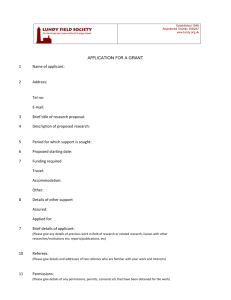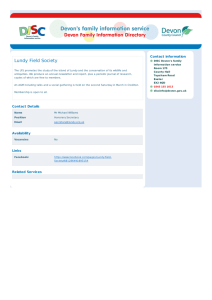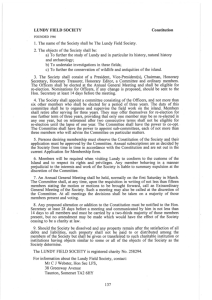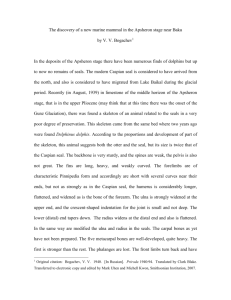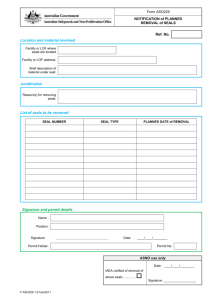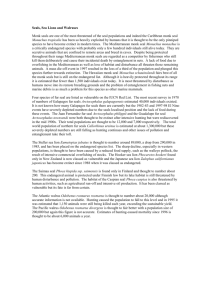Photo-I/D
advertisement
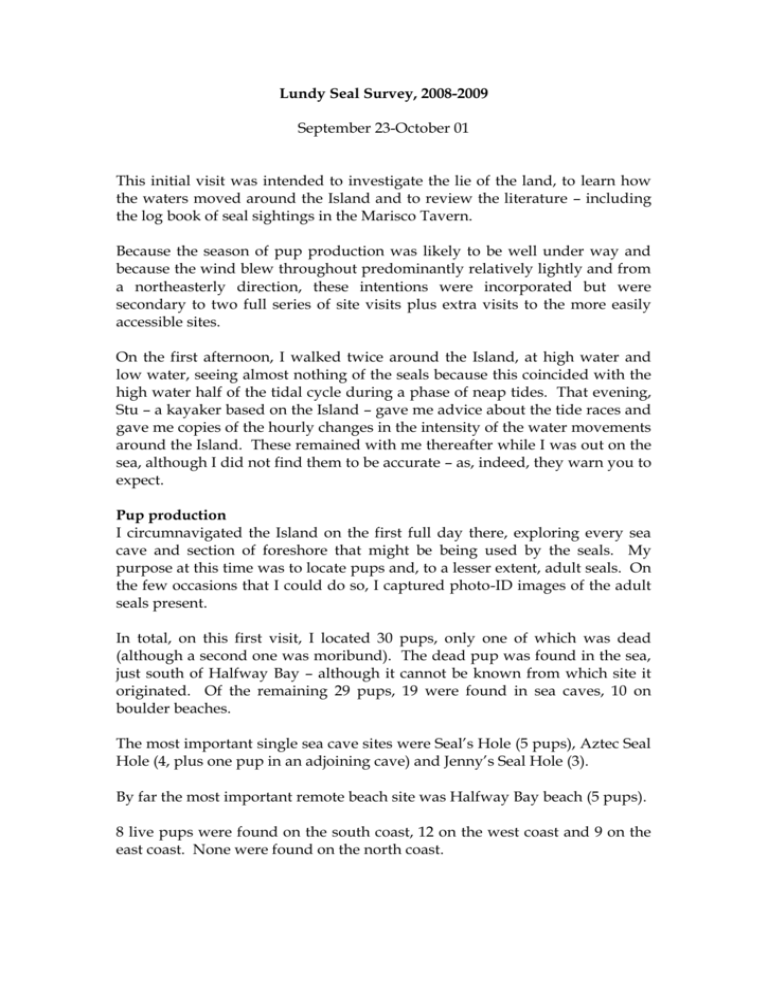
Lundy Seal Survey, 2008-2009 September 23-October 01 This initial visit was intended to investigate the lie of the land, to learn how the waters moved around the Island and to review the literature – including the log book of seal sightings in the Marisco Tavern. Because the season of pup production was likely to be well under way and because the wind blew throughout predominantly relatively lightly and from a northeasterly direction, these intentions were incorporated but were secondary to two full series of site visits plus extra visits to the more easily accessible sites. On the first afternoon, I walked twice around the Island, at high water and low water, seeing almost nothing of the seals because this coincided with the high water half of the tidal cycle during a phase of neap tides. That evening, Stu – a kayaker based on the Island – gave me advice about the tide races and gave me copies of the hourly changes in the intensity of the water movements around the Island. These remained with me thereafter while I was out on the sea, although I did not find them to be accurate – as, indeed, they warn you to expect. Pup production I circumnavigated the Island on the first full day there, exploring every sea cave and section of foreshore that might be being used by the seals. My purpose at this time was to locate pups and, to a lesser extent, adult seals. On the few occasions that I could do so, I captured photo-ID images of the adult seals present. In total, on this first visit, I located 30 pups, only one of which was dead (although a second one was moribund). The dead pup was found in the sea, just south of Halfway Bay – although it cannot be known from which site it originated. Of the remaining 29 pups, 19 were found in sea caves, 10 on boulder beaches. The most important single sea cave sites were Seal’s Hole (5 pups), Aztec Seal Hole (4, plus one pup in an adjoining cave) and Jenny’s Seal Hole (3). By far the most important remote beach site was Halfway Bay beach (5 pups). 8 live pups were found on the south coast, 12 on the west coast and 9 on the east coast. None were found on the north coast. The great majority of seal mothers were resting not on the nursery beaches but in the shallows approaching the beaches. All attendant males were resting a little farther offshore and at some distance from the seal mothers, who showed themselves aggressively hostile to solicitations from the male. Exceptions were where the mothers had clearly come into oestrus. In this event, the male and female interacted closely, usually in a languid manner, as a prelude to mating. I had no intention at this time to map the caves. That will happen at some time after the conclusion of the season of pup production. From the first circumnavigation until the penultimate day, when the wind direction backed to the northwest, it appeared that nearly all the seals present at Lundy sites were involved in pup production and its aftermath of mating, with the exception of one site. This was the sea cave at Puffin Gully, near to the northeast point of the Island. This is a particularly long cave, notably protected against wave action from most quarters and mentioned in most of the preceding seal studies recorded in various issues of the Annual Report of the Lundy Field Society. In addition, at high water spring tide, a boulder beach relatively sheltered from wave action does remain. I believe it is the prime candidate to be the main moulting cave, perhaps used by large numbers of seals during the winter months. Abundance & distribution While the wind blew predominantly from the northeast, and during a period of neap tides, the haul-out sites outside the nurseries around the Island were little used by seals, although up to 10 seals might be seen in the very sheltered bays (e.g. Long Roost) immediately south of the north lighthouse. However, on 30 September, the wind came around to the west, coinciding with a period of spring tides. Now, the skerries east of the north lighthouse were much used by seals while from North East Point south to Tibbett’s Point was heavily used by large numbers of seals. At all sites, females predominated, with just a small proportion being males or immatures. A tentative reaction to this, if it proves to be repeated, is that more seals haul out when the wind blows from the westerly quarter than from the east. Does this mean seals haul out more during westerlies and forage more during the easterlies, or might it mean that seal movements around the seas of southwest Britain are more active when winds blow from the easterly quarter. Puffin Gully was visited twice. On neither occasion was a pup found in the cave. Instead, on both occasions, there were more than 20 mature female seals present, none of them having produced a pup – this being ascertainable from examination of the body condition of the seals. This made Puffin Gully cave the principal single haul-out site being used at this time. It is worth noting that at sea cave and remote beach sites where seal pups were found, not only during this visit to Lundy but also during visits to seal nurseries in Cornwall, the Isles of Scilly, Devon, North Wales, the Isle of Man and Brittany, the only other seals present were seal mothers and attendant males, plus occasional ‘additional’ female seals who appear to have a ‘buddy’ relationship with the seal mother. In effect, all ‘non-essential’ seals shun these sites. Therefore, you should not expect to find a pup in a sea cave occupied by 20-plus seals. Therefore, Puffin Gully cave appeared to function as a ‘rest’ room or else as a waiting room for females who have yet to produce young. No other non-nursery cave contained more than one mature seal, this usually being asleep in the entrance waters. In review, it appears that all but one sea cave as well as all remote beach sites are being used exclusively by seals involved in pup production and its aftermath of mating. The number of female seals currently present at and adjacent to Lundy sites greatly exceeds the number of males. Only very few yearlings are present. Therefore, at what is likely to prove to be the height of the season of pup production, Lundy is functioning almost exclusively as a nursery for the seals. Conceivably, the lone sea cave site used by relatively large numbers of female seals functions as a waiting room for pregnant seals – although this must be regarded as an instinctive reaction and therefore a tentative viewpoint that remains to be tested. Photo-I/D A small number of photo-I/D images were captured, including the full set of left and right profile plus a chest shot for two seal mothers at Halfway Bay. In general, as I was operating alone and because I was uncertain about the tidal streams, I concentrated on identifying where the pups were located and in what numbers. Literature Review Making use of the Marisco Tavern library, I read the following: Baillie, C.C. and Clark, N.A. 1974. Brief visits to the sea-level caves on the east side of Lundy. Annual Report of the Lundy Field Society, 25, pp.59-62. Chanter, J.R. London. 1877. Lundy Island. 248pp. Langmans, Green and Co., Chilvers, R., Colebourne, M., Grant, B., Oliver, R. and Lea, S. 1999. Vigilance in Grey Seals as a Function of Time Since Haul Out. Annual Report of the Lundy Field Society, 50, pp.41-48. Clark, N.A. and Baillie, C.C. 1973. Observations on the Grey Seal (Halichoerus grypus) populations of Lundy. Annual Report of the Lundy Field Society, 24, pp.41-42. Clark, N.A. 1977. The composition and behaviour of the grey seal colony of Lundy. Annual Report of the Lundy Field Society, 28, pp.32-38. Hook, O. 1963-64. Grey Seals (Halichoerus grypus) at Lundy. Annual Report of the Lundy Field Society, 16, pp.24-25. Loyd, L.R.W. 1925. Lundy; its history and natural history. London. Willcox, N. 1986. A review of Grey Seal (Halichoerus grypus) pupping on Lundy, and some new observations. Annual Report of the Lundy Field Society, 37, pp.32-34. Willcox, N. 1987. Grey Seal Pupping on Lundy in 1987. Annual Report of the Lundy Field Society, 38, p.47. Future survey work The next visit will be made in the third week of October. As this continues to be part of the season of pup production, the ideal will be to revisit all seal sites during one major circumnavigation of the island. This can be accomplished with greater peace of mind with the promised boat support of the warden while surveying the west coast and any windward site. If the pup production work can be accomplished in the one day, this leaves more time to be given over to the capture of photo-ID images. However, the first priority at this time is to keep disturbance at the nursery sites to a minimum. Therefore, expectations regarding any image catalogue of mature seals involved in pup production and subsequent mating should be muted. Sea caves used by seals will be mapped during a period when sea conditions are quiet and when the season of pup production is concluded. I hope to produce two maps for every site, one being a low water view on a spring tide and the other being low water neap tide. Stephen Westcott. 09 October, 2008
